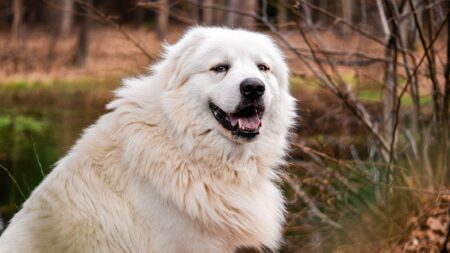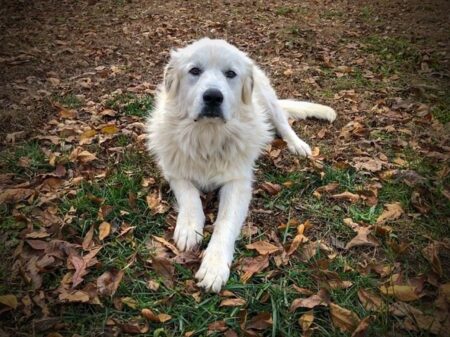
Do Great Pyrenees Shed? We Have the Answer!
Wondering if you’ll be living with a big, fluffy dog or a never-ending cycle of grooming? The Great Pyrenees is one of those beautiful, big breeds that come with a lot of fur. Known for their gentle nature, they’re a popular choice as family pets. But, before you bring one home, you’ll want to know just how much fur they shed. So, if you’re curious about whether or not the Great Pyrenees shed, you’ve come to the right place!
SEE ALSO: Do Bulldogs Shed? We Have The Answer
Do Great Pyrenees Shed? We Have the Answer!
Yes, the Great Pyrenees do shed! They have a double-layer coat, which consists of a thick, insulating undercoat and a longer, coarser outer coat and the coat helps to protect them from the cold and harsh environments that they were bred to thrive in, but it does come with some extra fur management on your end.
So, how much do the Great Pyrenees shed? Well, they’re known to be seasonal shedders, meaning they shed more in spring and fall as they adjust to the changing temperatures.
Overview of Great Pyrenees
Great Pyrenees are beautiful, protective, and loyal dogs that require consistent grooming and plenty of exercise to stay healthy and happy. With proper care, they can make wonderful family pets and lifelong companions.
- Height: Males average 27 to 32 inches tall; females average 25 to 29 inches tall.
- Weight: Males average 100 to 160 pounds; females average 80 to 120 pounds.
- Colors: The coat can be white, white with patches of cream, grey, tan, or red.
- Coat: A thick, weather-resistant double coat consisting of a dense undercoat and a coarse outer coat.
- Lifespan: 10 to 12 years on average.
- Cost: Great Pyrenees can cost anywhere from 00 to 00
- Grooming: Great Pyrenees require regular grooming, including brushing several times a week to remove loose hair and prevent matting. They shed seasonally, so expect to see more fur during certain times of the year. They should also be bathed every 6 to 8 weeks or as needed.
When Do Great Pyrenees Lose Their Puppy Coat?
Great Pyrenees typically lose their puppy coats at around 6 to 9 months of age. This process is known as “blowing the puppy coat” and can take several weeks to complete. During this time, you may notice your Pyrenees shedding more than usual.
The puppy coat is a thin, soft coat that provides insulation for the puppy in its early months of life and as the puppy grows and matures, the adult coat starts to come in, which is thicker and more weather-resistant. The shedding of the puppy coat is a natural process that allows the adult coat to grow.
Great Pyrenees Shedding Season
Like many double-coated breeds, Great Pyrenees have a seasonal shedding pattern. They tend to shed more heavily twice a year, during the spring and fall.
Spring Shedding: As the weather starts to warm up, Great Pyrenees will shed their thick winter coat to make way for a lighter summer coat. This shedding typically starts in late March or early April and can last for several weeks.
Fall Shedding: As the weather cools down in the fall, the Great Pyrenees will start to grow a thicker winter coat.
This shedding typically occurs in late September or early October and can also last for several weeks.
During these shedding seasons, you may find yourself cleaning up lots of loose fur around your house. You may also want to brush your Great Pyrenees more frequently to help remove loose fur and prevent it from getting everywhere.
Why is My Great Pyrenees Not Fluffy?
If your Great Pyrenees isn’t as fluffy as you expected, there could be several reasons why. Here are some potential causes:
- Diet: A poor diet can cause your Great Pyrenees to have a dull or thin coat. Make sure your dog is getting all the nutrients it needs, including protein, fatty acids, and vitamins.
- Stress: Stress can cause your dog to shed excessively or have patchy fur. Stressful events, like moving to a new home or the loss of a family member, can cause your dog’s coat to suffer.
- Age: Puppies have thinner, less fluffy coats than adult Great Pyrenees. As your dog grows, its coat should become thicker and fluffier.
- Health Issues: Certain health issues, such as hypothyroidism, Cushing’s disease, or skin allergies, can cause your Great Pyrenees to have a thinner or less fluffy coat. If you suspect that your dog has a health issue, it’s important to take them to the vet for a check-up.
- Genetics: Some Great Pyrenees are naturally less fluffy than others. If your dog’s parents weren’t very fluffy, there’s a good chance your dog won’t be either.
- Grooming: If you’re not grooming your Great Pyrenees properly, their coat may become dull or matted. Make sure to brush your dog regularly and use the right grooming tools for their coat type.
- Environment: Extreme temperatures, humidity, and dryness can all affect your Great Pyrenees’ coat.
Great Pyrenees Shedding in Clumps
When a Great Pyrenees sheds hair in clumps, it could be a sign of a health issue or poor grooming. Here are some possible reasons why your dog might be shedding in clumps:
- Skin Allergies: Dogs can develop allergies to a variety of things, including food, fleas, and environmental allergens. These allergies can cause your dog to scratch excessively, which can lead to hair loss.
- Hypothyroidism: Hypothyroidism is a condition that occurs when the thyroid gland doesn’t produce enough hormones. One of the symptoms of hypothyroidism in dogs is hair loss, which can often be in clumps or patches.
- Cushing’s Disease: Cushing’s disease is a condition that causes the adrenal glands to produce too much cortisol. One of the symptoms of Cushing’s disease is hair loss, which can be diffuse or in patches.
- Poor Grooming: If your Great Pyrenees aren’t being groomed properly, their hair can become matted and tangled. This can cause the hair to come out in clumps when brushed.
What Are The Characteristics Of A Great Pyrenees
Great Pyrenees are large, gentle dogs with a unique blend of characteristics like:
- Appearance: Great Pyrenees have a thick, white coat that can range from wavy to straight, with black or tan patches occasionally appearing on the ears or face. Their ears are typically folded forward and their tail is long and plumed. They have a large, powerful build and weigh between 100 and 160 pounds.
- Temperament: They are known for their gentle nature, patience, and loyalty, but can also be stubborn at times. They are protective of their families and have a strong herding instinct.
- Activity Level: Great Pyrenees are active dogs that enjoy daily exercise, but they also appreciate spending time lounging around. They can be prone to laziness if not given the right amount of exercise.
- Intelligence: They are intelligent dogs that are easy to train but can also be headstrong. Consistency and positive reinforcement are key when training a Great Pyrenees.
- Barking: Great Pyrenees were bred as guard dogs, so they tend to bark a lot, especially at night. This can be mitigated with training and exercise.
- Health Issues: Like all dogs, Great Pyrenees are prone to certain health issues such as hip dysplasia, bloat, and skin allergies. Regular vet check-ups and preventative care are important for maintaining their health.
- Grooming Needs: Great Pyrenees have a thick coat that requires regular brushing and grooming to keep it healthy and free of mats and tangles.
- Compatibility: Great Pyrenees are great family dogs, but they are not recommended for apartment living due to their size and barking tendencies.
What Are The Pros And Cons of A Great Pyrenees?
Great Pyrenees are wonderful dogs, but like all breeds, they have their pros and cons. Here are a few things to consider before deciding if a Great Pyrenees is the right breed for you:
Pros:
- Gentle and Patient: Great Pyrenees are known for their gentle and patient nature, making them excellent family pets.
- Protective: They have a strong herding instinct and will protect their family and property from intruders.
- Intelligent: They are easy to train and respond well to positive reinforcement.
Cons:
- Barking: Great Pyrenees were bred to bark and protect their flock from predators. If not trained properly, they may bark excessively, which can be a problem in neighborhoods with noise restrictions.
- Size: Great Pyrenees are large dogs that require a lot of space. They are not recommended for apartment living.
- Shedding: Great Pyrenees have a thick coat that sheds a lot. They require regular grooming to keep their coat healthy and free of mats and tangles.
How Much Maintenance Is Required For Great Pyrenees?
Great Pyrenees are considered to be moderate maintenance dogs, requiring a fair amount of care to stay healthy and happy.
The great Pyrenees have a thick double coat that sheds seasonally and year-round. Regular grooming is necessary to keep the coat healthy and free of mats and tangles. You should brush your Great Pyrenees at least 2-3 times a week and bathe them every 4-6 weeks.
SEE ALSO: Border Collie Shedding: How to Maintain Your Dog’s Coat
FAQs:
Q. Why are my Great Pyrenees losing hair?
Potential causes of hair loss in Great Pyrenees include allergies, stress, nutritional deficiencies, or medical conditions like hypothyroidism or Cushing’s disease.
Q. Does a Great Pyrenees shed?
Yes, Great Pyrenees have a thick double coat and shed moderately year-round, with heavier shedding during seasonal changes.
Q. Do Great Pyrenees shed all year?
Yes, Great Pyrenees shed moderately throughout the year with a heavier shed during spring and fall.
Q. Do Great Pyrenees shed in the summer?
Yes, Great Pyrenees shed their winter coat during summer, resulting in increased shedding.
How long does it take for a Great Pyrenees fur to grow back?
Great Pyrenees fur can take up to six months to fully grow back after shedding.


